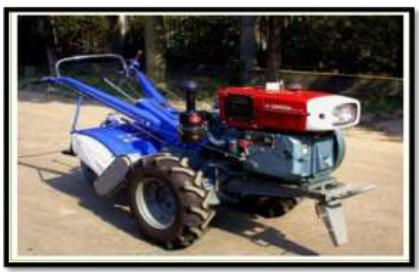ABSTRACT
This paper presents a semi-automatic pesticide sprayer system which operates using solar power. The semiautomatic sprayer is a three wheeled vehicle which sprays pesticide in any given vineyard with almost nil human assistance. The vehicle is powered using an on board solar powered battery which brings down the running cost. Solar energy is first used to charge a storage battery.
The solar energy stored in the battery is utilized to operate motor which functions as pump. In this project we are trying to make a prototype model for farmers and cultivators for whom spraying of insecticides is harmful and hazardous. The control of the vehicle is achieved using an inbuilt microcontroller unit which is programmed to respond to the zigbee wireless device.
METHODS

Fig.1 Hand Compression Spray.
Hand compression sprayers are either pressure retaining or non-pressure retaining type. The pressure retaining type has an advantage that air charged once may last for weeks, but requires sturdy tank and high pressure, therefore these are not in common use. Nonpressure retaining type is the most commonly used hand compression sprayer.

Fig.2 Power Tiller sprayer.
The power sprayer consists of an integrated or external spray tank; a high pressure piston pump usually powered by a petrol engine a pressure regulating valve and a hose of up to 50 m of length. Spray tanks are too big to be carried as a knapsack. The power sprayer is produced in a number of versions.
SCOPE OF RESEARCH
Autonomous service robots for orchards and vineyards: 3d simulation environment of multi sensor based navigation and applications Linz, A. Ruckelshausen and E. Wunder. The authors are working in the fields of unmanned or remote controlled autonomous field robots, navigation, image-based sensors fusion as well as agricultural applications. Within an interdisciplinary research group these technologies are transferred to robot applications in vineyards and orchards.
The goal is the availability of an autonomous service robot, whereas first applications are site-specific plant protection (e.g. precise spraying), mulching and picking up fruit boxes. A first version of the robot with electrical drives and precise sprayers has already been developed. The applications, however, show a large range of field conditions which have to be considered for the vehicle application design. Thus the authors have developed a 3D simulation environment which allows the virtual test of the robot platform prior to its application.
PROPOSED METHODOLOGY AND DISCUSSION

Fig. 3.1 Block diagram of Transmitter.

Fig.3.2 Block diagram of Receiver.
The proposed system Automatic Pesticide Sprayer which is expected to achieve better results compared to the previous methods without any nil human assistance. This would be a semiautomatic mechanical model that would work automatically powered by solar energy and reduce drudgery and also protect the farmers and cultivators from harmful pesticides and chemicals. Proposed system requires IR sensors, Motor drivers, Zigbee transmitter & receiver and controller as main blocks for the design.
CONCLUSIONS
This project demonstrates the implementation of robotics and mechatronics in the field of agriculture. This being a test model the robustness of the vehicle is not very high. The performance is satisfactory under laboratory condition. The model gave a fairly good rate of area coverage and the cost of operation as calculated was also reasonably low. In addition the safety and long term health of the farmers is ensured by eliminating human labour completely from this process. It does not compromise the performance of a petrol based pesticide sprayer.
The future scope of this project include –
- Take up build a full-scale prototype which can be utilized in the fields in real time.
- Facilitate charging of the battery using a solar charger thus bringing the costs even further down.
- Battery energy can be saved by using PWM scheme for driving pump.
Source: Visvesvaraya Technological University
Authors: Ahalya M | Muktha A | Veena M | Vidyashree G | Rehna V J
>> More Wireless Energy Projects for Final Year Students
>> More Wireless Projects Using Zigbee for Engineering Students
>> More Wireless Projects Using Microcontroller for Engineering Students